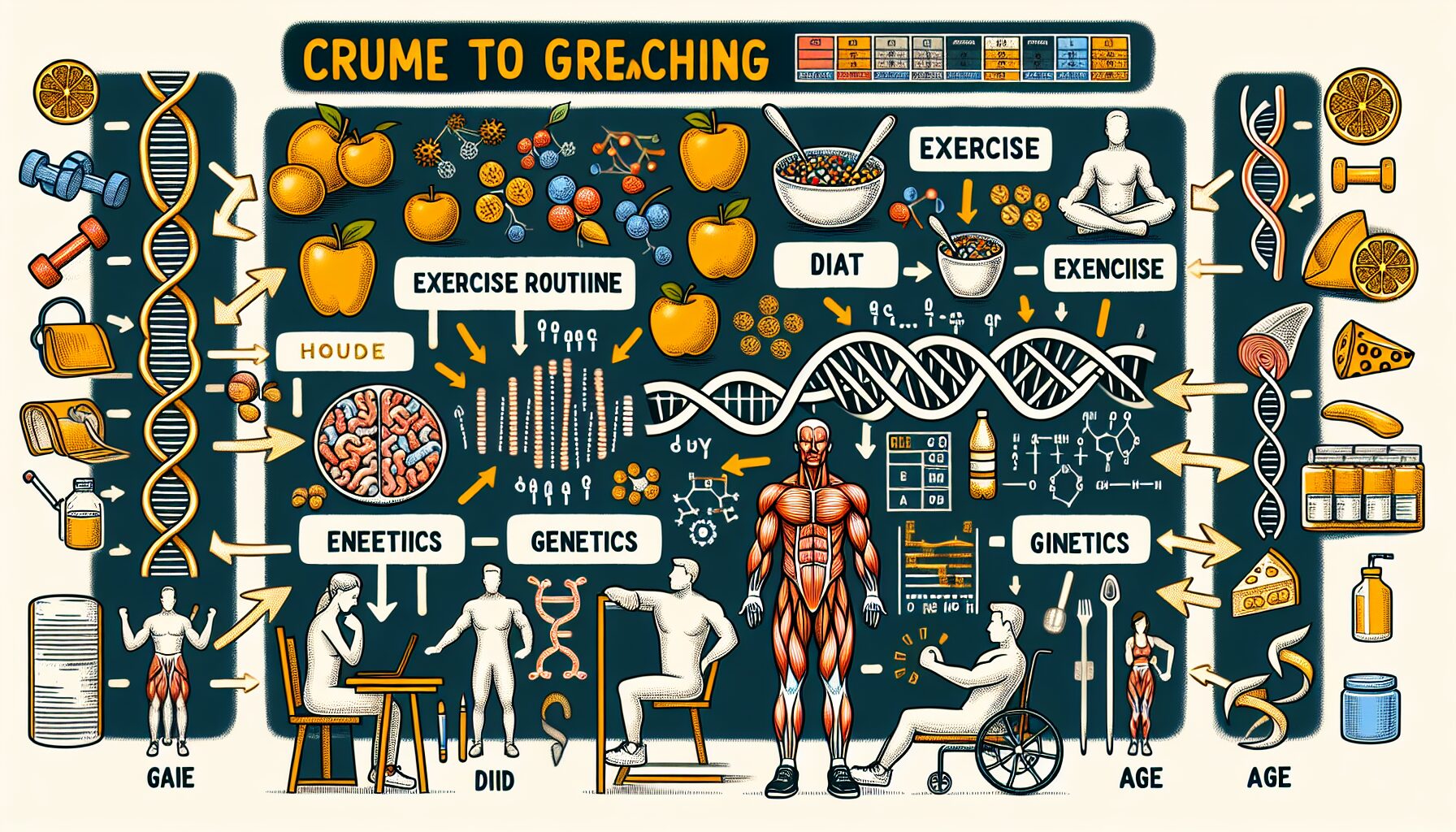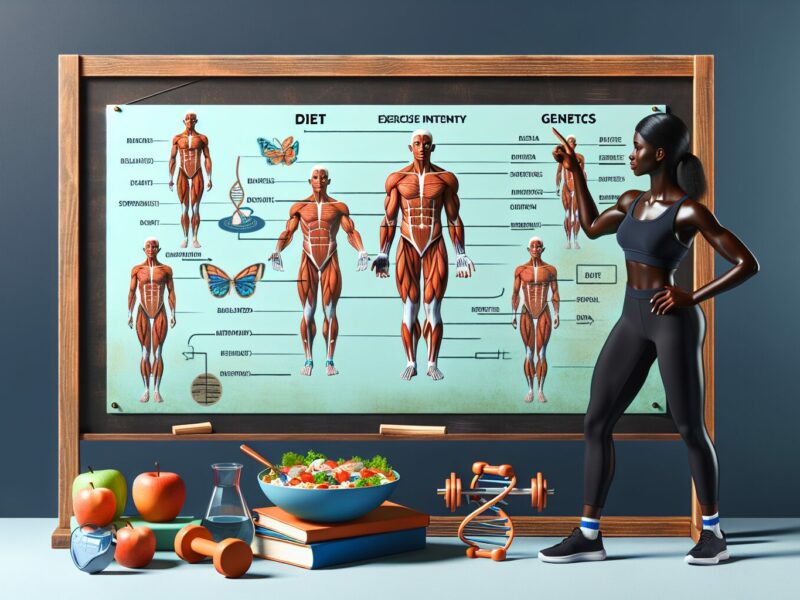So you’ve been hitting the gym and pumping those weights, eager to sculpt those muscles and achieve that enviable toned physique. But the burning question on your mind is: how long will it actually take to see those results? Well, fret not my friend, because in this article, we’re going to uncover the truth behind the time it takes to obtain visible muscle tone. No more guessing or hoping, we’re about to give you the real scoop on your fitness journey. Prepare to be pleasantly surprised and motivated as we delve into the factors that influence your progress and the approximate timeframe you can expect to start seeing those stunning muscles take shape.

Factors Affecting Muscle Tone
Muscle tone refers to the level of tension and firmness in your muscles, and it is influenced by various factors. Understanding these factors can help you optimize your efforts towards achieving visible muscle tone.
Genetics
One crucial factor that affects muscle tone is genetics. Your genetic makeup plays a significant role in determining your muscle fiber composition, muscle length, and the potential for muscle hypertrophy. Some individuals may naturally have a higher muscle tone due to genetic factors, while others may struggle to develop visible muscle tone even with consistent training and proper nutrition. While genetics cannot be changed, understanding your unique genetic predispositions can help you set realistic expectations and tailor your fitness routine to maximize your potential. Remember, everyone’s genetic potential is different, and focusing on individual progress is key.
Body Composition
Another important factor in achieving muscle tone is your overall body composition. Muscle tone becomes more visible when you have a lower body fat percentage. Body fat tends to conceal muscle definition, so reducing overall body fat through a combination of exercise and a healthy diet is vital in enhancing muscle tone. Additionally, having a higher proportion of lean muscle mass contributes to a more toned appearance, as muscle is denser than fat. Therefore, it is crucial to engage in resistance training and follow a balanced nutrition plan to build and maintain lean muscle mass.
Age
Age is also a factor that impacts muscle tone. As we age, our bodies naturally go through physiological changes that can affect muscle tone. The decline in muscle mass and strength, known as sarcopenia, is a common occurrence with aging. However, engaging in regular strength training exercises can help counteract the effects of age-related muscle loss and maintain muscle tone. It is never too late to start, and consistent effort can yield noticeable improvements in muscle tone at any age.
Workout Routine
Your workout routine plays a significant role in developing muscle tone. Incorporating exercises that target specific muscle groups will help stimulate muscle growth and enhance definition. Resistance training exercises, such as weightlifting, are particularly effective in building muscle tone. These exercises create microscopic tears in your muscle fibers, which then rebuild stronger and more defined during the recovery phase. Additionally, focusing on compound exercises that work multiple muscle groups simultaneously can efficiently develop overall muscle tone. Consistency and variety in your workouts are key to continually challenging your muscles and encouraging growth.
Nutrition
Proper nutrition is essential for building muscle tone. Your diet should support your exercise routine by providing adequate nutrients for muscle growth and repair. Here are some key aspects of diet and nutrition for building muscle tone:
Caloric Surplus
To build muscle tone, you need to consume a caloric surplus – consuming more calories than your body burns. This surplus provides the energy needed for muscle growth. It is crucial to focus on consuming nutrient-dense foods and avoiding excessive processed foods or empty calories. Balancing your caloric intake with your energy expenditure is essential for achieving sustainable muscle tone.
Protein Intake
Protein is the building block of muscle tissue. Adequate protein intake is necessary to support muscle growth and repair. Aim to consume a variety of lean protein sources, such as poultry, fish, eggs, and plant-based options like legumes and tofu. The recommended protein intake for muscle building is around 0.8 to 1 gram of protein per pound of body weight.
Macronutrient Balance
While protein is crucial, it is also important to maintain a balanced intake of carbohydrates and healthy fats. Carbohydrates provide the energy needed for workouts, while healthy fats support hormone production and overall health. Focus on consuming complex carbohydrates, such as whole grains and vegetables, and prioritize sources of healthy fats, such as avocados and nuts.
Water Consumption
Staying adequately hydrated is often overlooked but essential for muscle tone. Water supports proper muscle function, facilitates nutrient absorption, and aids in recovery. Aim to drink enough water throughout the day to stay hydrated, especially during and after workouts.
Types of Exercises for Building Muscle Tone
Incorporating a variety of exercises into your fitness routine is crucial for building muscle tone. Different types of exercises target distinct muscle groups, allowing for comprehensive muscle development and definition.
Resistance Training
Resistance training, such as weightlifting or using resistance bands, is a fundamental component of building muscle tone. These exercises challenge your muscles by providing resistance, ultimately leading to muscle hypertrophy and increased muscle tone. Focus on compound exercises that work multiple muscle groups simultaneously, such as squats, deadlifts, and bench presses. Additionally, incorporate isolation exercises that target specific muscles to enhance definition in those areas.
Cardiovascular Exercise
While resistance training is essential for building muscle tone, incorporating cardiovascular exercise is equally important. Cardiovascular exercises, such as running, cycling, or swimming, help burn calories, reduce overall body fat, and improve cardiovascular health. When combined with resistance training, cardiovascular exercise can help reveal the muscle tone you have built by reducing overall body fat.
Flexibility and Mobility Work
Flexibility and mobility exercises are often overlooked but play a significant role in muscle tone. Stretching and mobility exercises help improve joint range of motion, enhance muscle elasticity, and promote overall functional fitness. Incorporate exercises like yoga, Pilates, or stretching routines specifically targeting muscle groups that may be tight or imbalanced to improve overall muscle tone and movement efficiency.
Frequency and Duration of Exercise
The frequency and duration of your exercise routine play a vital role in developing muscle tone. Consistent effort, progressive overload, and appropriate recovery are key aspects to consider.
Consistency
Consistency is crucial when it comes to exercise. Aim for regular workouts that include a combination of resistance training, cardiovascular exercise, and flexibility/mobility work. Consistency leads to long-term progress and visible muscle tone. It is better to have consistent shorter workouts throughout the week rather than sporadic marathon workout sessions.
Progressive Overload
To continually stimulate muscle growth and progress, it is important to incorporate progressive overload into your workouts. Gradually increasing the intensity, weight, or resistance of your exercises challenges your muscles and promotes development. This can be achieved by adding more weight, increasing repetitions, or shortening rest periods between sets. By continually challenging your muscles, you encourage them to adapt and grow stronger, leading to improved muscle tone.
Recovery and Rest Days
Rest and recovery are essential for muscle growth and overall fitness progress. During resistance training, your muscles undergo microscopic tears that require adequate rest and recovery to repair and strengthen. Allow at least one or two rest days per week where you engage in lighter exercises, stretching, or total rest to give your muscles time to recover and rebuild. Proper sleep, hydration, and nutrition also contribute to optimal recovery.
Expected Time Frame for Visible Muscle Tone
The time frame for visible muscle tone varies depending on several factors, including your fitness level, genetics, and consistency. While individual results may differ, here are some general timelines to consider:
Beginners
For individuals new to resistance training and seeking visible muscle tone, you can typically start noticing improvements within 4-8 weeks of consistent training and proper nutrition. During this time, your body starts adapting to the new stimulus, and muscle tone gradually becomes more apparent.
Intermediate Lifters
Intermediate lifters who have been consistently engaging in resistance training for several months can expect more noticeable muscle tone within 4-6 months. As your muscles continue to adapt and grow stronger, you will likely experience increased definition and a more sculpted appearance.
Advanced Lifters
For individuals who have been training consistently for a year or more, achieving optimal muscle tone may take longer due to diminishing returns. However, with strategic programming, nutrition, and ongoing progression, you can still make noticeable improvements in muscle tone over time. Continued commitment and dedication are essential for advanced lifters looking to push their limits and achieve their desired level of muscle definition.

Modifications for Faster Results
If you are looking to expedite your progress towards visible muscle tone, there are various modifications you can make to your training routine and nutrition plan.
Increasing Training Intensity
One effective way to accelerate muscle tone development is to increase the intensity of your workouts. This can be achieved by lifting heavier weights, increasing the number of sets and repetitions, or incorporating advanced training techniques such as drop sets or supersets. Intensifying your workouts challenges your muscles further and stimulates greater muscle growth and definition.
Adjusting Nutrition Plan
Fine-tuning your nutrition plan can also enhance your results. Consider consulting with a registered dietitian or nutritionist to optimize your macronutrient distribution, caloric intake, and supplementation if necessary. They can provide personalized guidance based on your specific goals and help ensure you are fueling your body optimally for muscle tone development.
Supplement Usage
Supplements can be used as tools to support your muscle tone goals, but they should not be relied upon as shortcuts. Popular muscle-building supplements such as protein powder, creatine, and branched-chain amino acids (BCAAs) can supplement your nutrition plan and aid in muscle recovery and growth. However, it is important to remember that supplements should always be used in conjunction with a balanced diet and consistent exercise routine.
Common Mistakes and Plateaus
While working towards visible muscle tone, it is important to be aware of common mistakes and plateaus that can hinder progress. By avoiding these pitfalls, you can maximize your efforts and continue to see improvements in muscle tone.
Lack of Consistency
Consistency is key when it comes to building muscle tone. Inconsistent workouts and sporadic nutrition will make it difficult to achieve visible results. Aim for regular workouts and adhere to a balanced nutrition plan to create an environment conducive to muscle growth.
Overtraining
While it is important to challenge your muscles, overtraining can lead to diminished results. Overtraining occurs when you do not allow enough time for proper recovery and rest between workouts. This can lead to muscle fatigue, decreased performance, and increased risk of injury. Listen to your body and give it the rest it needs to rebuild and grow stronger.
Ignoring Recovery
Recovery is essential for muscle growth and overall progress. Ignoring recovery, including adequate sleep, hydration, and rest days, can hinder your efforts towards visible muscle tone. Be mindful of your body’s signals and prioritize recovery practices to optimize your progress.
Not Adjusting Progression
Continued progression is vital for continuous muscle growth and definition. Failing to adjust the intensity, volume, or variety of your workouts can lead to plateaus. Gradually increase the challenge of your exercises by adjusting weight, repetitions, or sets to ensure ongoing progress and improvement.
Improper Form
Performing exercises with improper form not only reduces their effectiveness but also increases the risk of injury. It is crucial to prioritize proper form and technique to engage the targeted muscles effectively and safely. If needed, consult with a qualified fitness professional to ensure proper form and technique in your workouts.

Monitoring Progress and Success
Tracking your progress is essential for staying motivated and assessing your muscle tone development. Here are some ways to monitor your progress effectively:
Regular Assessment
Regularly assess your muscle tone progress by observing changes in your body composition and muscle definition. Take note of how your clothes fit, the visibility of muscle striations, and overall changes in muscle tone. While progress may be slow, incremental improvements over time signify success.
Body Measurements
Taking body measurements can provide valuable insights into your muscle tone development. Measure key areas such as your arms, legs, waist, and hips regularly and compare the measurements over time. This will help you track changes in muscle size and overall body composition.
Progress Photos
Taking progress photos is an effective visual tool for tracking muscle tone development. Take front, back, and side-view photos in consistent lighting and pose them in the same way every few weeks. Comparing these photos over time can help you see subtle changes in muscle definition that may not be apparent on a day-to-day basis.
Strength and Performance
Tracking your strength and performance improvements can also indicate progress in muscle tone development. Keep a record of the weights, repetitions, and sets you perform in your exercises. As you notice increases in strength and endurance, it is a positive sign that your muscles are growing and becoming more defined.
Importance of Patience and Persistence
Building visible muscle tone is a journey that requires patience and persistence. It is important to set realistic expectations and adopt a sustainable approach to avoid disappointment and burnout. Here are some key points to remember:
Setting Realistic Expectations
Everyone’s body is different, and the rate at which visible muscle tone develops will vary. Avoid comparing yourself to others and focus on your own progress. Celebrate incremental improvements and recognize that building muscle tone takes time. Set realistic goals and adjust them as necessary to stay motivated and committed.
Emphasizing Long-Term Goals
While it is natural to desire quick results, it is important to prioritize long-term goals. Building sustainable muscle tone requires consistent effort over time. Emphasize the importance of maintaining a healthy lifestyle, rather than solely focusing on short-term aesthetic goals. Remember that the benefits of regular physical activity and proper nutrition go beyond visible muscle tone, contributing to overall well-being and longevity.
Adopting a Sustainable Approach
Consistency is key, so adopt a fitness routine and nutrition plan that you enjoy and can maintain in the long run. Choose activities that you find enjoyable, and fuel your body with nutritious and delicious foods. The more sustainable and enjoyable your approach, the more likely you are to stick with it and see long-term muscle tone development.
Enjoying the Journey
Building muscle tone is not just about the end result; it’s about the journey itself. Embrace the process, celebrate small victories, and find joy in the daily progress you make. By adopting a positive mindset and finding enjoyment in your workouts and nutrition plan, you are more likely to stay committed and achieve lasting success.

Conclusion
Building visible muscle tone involves a combination of factors, including genetics, body composition, age, workout routine, and nutrition. By understanding these factors and implementing the right strategies, you can enhance your muscle tone and achieve the sculpted, defined physique you desire. Keep in mind that muscle tone development takes time, so patience, persistence, and a sustainable approach are crucial. Focus on consistent effort, proper nutrition, and well-designed workouts to maximize your potential and enjoy the journey towards a more toned and defined you.


